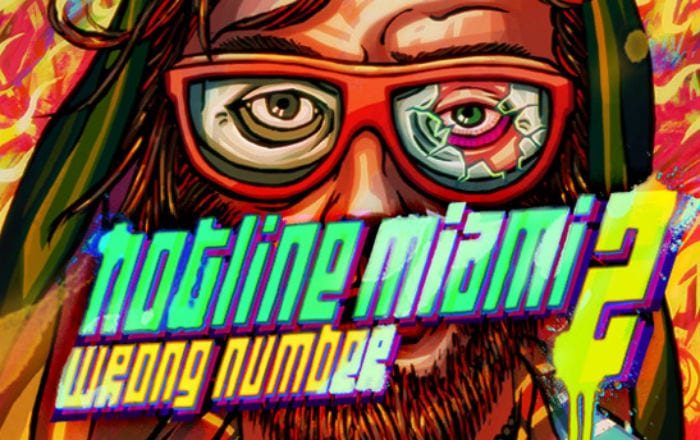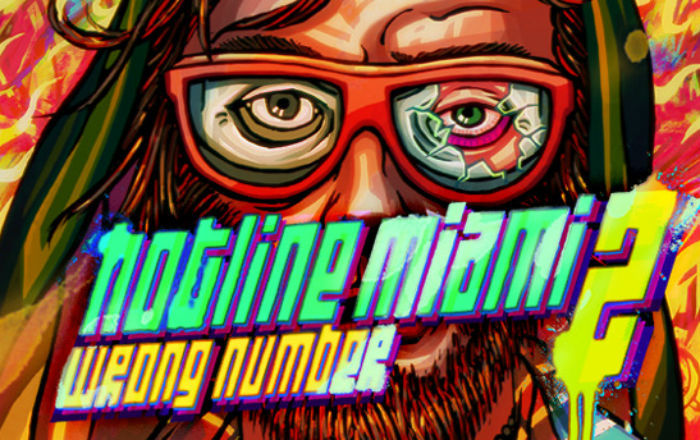
Written by Laird Allen
Hotline Miami 2: Wrong Number
Wrong Number is (More Than) All Right
Hotline Miami 2: Wrong Number is a sequel to 2012’s breakaway indie hit. Developed by Dennaton Games and published by Devolver, the first entry in the series was a tremendous financial and critical success thanks to its relentlessly stylish design, music, and blurry, neon-tinged horror show story and hyperviolent gameplay. Hotline Miami 2 is the conclusion of the series, a worthy followup and a game that advances its formula even where it missteps.
The Hotline Miami series is an above-view, real time action game in a deliberately retro 16 bit style. The core of the gameplay experience is a blur of violent action as your character, equipped with an animal mask that imbues mysterious power, rampages through a series of buildings in late 80s, early 90s Miami, obeying a series of mysterious phone calls that seem innocuous but lead you to commit acts of staggering violence wherever you go, killing everyone in the building with anything you can find. Everything from knives and guns to pool cues and skateboards can be used, generally with horrifying results.
The gameplay is centered on this extremely fast, violent energy, and the character is generally just as vulnerable as their enemies- any hit will kill you. There’s no save system except for at the end of levels, but there’s also no limitations on retries. You simply have to do each level over and over again until you do it perfectly. If you die- and you will die, hundreds and hundreds of times- then you’re a tap of the R button away from a reset and trying again. The music doesn’t even pause. You just start again, sometimes with very minor changes in the enemy positioning and equipment, but usually it’s identical until you nail it or give up in fingernail-chewing frustration.
The core of the Hotline Miami experience is the same in this, the final entry of the series, but with some significant changes. The masks now offer much larger advantages and drawbacks compared to the previous game, sometimes altering core game mechanics (several remove the ability to scavenge weapons, for example.). The levels are much bigger, which is good and bad. There’s tons more art available, so the game’s levels are divided between several locations with distinct aesthetics ranging from jungle to strip joint to flophouse. The new characters play very differently, although for story reasons not all levels can be played with all masks, which is disappointing. All in all, the game isn’t afraid to try new things, and after the success of the first game in the series, it has room to spread its wings.
Unfortunately, not all the changes work. The new, expansive size of the levels is a major problem, for example. This is technically an improvement, but it hampers the gleeful spree energy that was so integral to the first game. For example, it makes levels much longer – which is not good in the live, die, repeat atmosphere of rambunctious violence that characterizes the series aesthetic, as a lot of progress can be lost to one enemy firing a shotgun through a window from beyond your character’s visual range. The larger size makes a much more cautious playstyle advisable – which is good emergent storytelling, since many of the characters in Hotline Miami 2’s fractured narrative in fact are much more cautious than the first game’s Jacket, but which can make fans of Hotline Miami 1 intensely, volcanically frustrated.
Another major feature of Hotline Miami 2 is the vastly expanded storytelling. Without spoiling the game for readers, it can be stated that HLM2 has a lot of story to tell and it goes about it with vigor – so much so that playing the first game is basically required. But some things don’t need the depth of storytelling that HLM2 indulges in. The series felt stronger when it was all fevered imagination and tone. Explicitly detailed backstories hamper that feeling. It also makes the choice to place itself in an ahistorical world, which frees the game from the constraint of reality. But that same freedom cheapens the revelations the story provides, because it’s no longer a lost chapter in our history – it’s a fantasy-world 1980s, and the blow is cushioned by that distance. That said, whether you like it or not, no one can accuse Hotline Miami 2 of failing to follow its premise to its logical conclusion nor of shying from the consequences.
In the end, where Hotline Miami 2 fails, it fails not from the lack of ambition that has plagued the recent triple-A titles I’ve reviewed, but rather from seeking to be more than it is. It makes many statements about obsession, madness, patriotism, sexual violence, fandom, art, drugs, and follows through on them, to the point of horror and beyond. Supported by brilliant techno, electronic, and Outrun music- the soundtrack alone is worth the purchase price, to be honest- and a retro aesthetic, Hotline Miami 2: Wrong Number is a game and an objet d’arte, and I recommend it strongly to gamers with strong stomachs and sick senses of humor.
Hotline Miami 2: Wrong Number is by Dennaton Games and is available through Steam and Good Old Games for 14.99 for Mac, PC, and Linux. It is also available through Sony for PS4, PS3, and Vita. It is suitable for mature gamers only.




